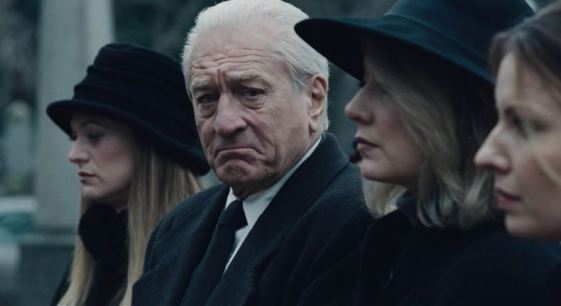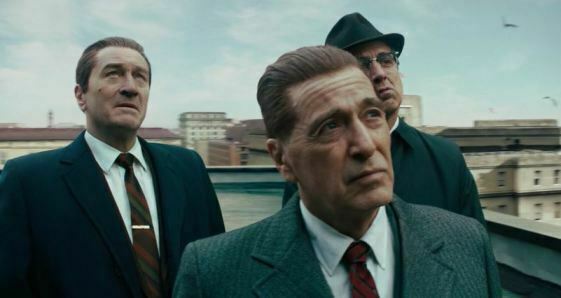
Martin Scorsese has been inveighing against modern cinema trends. He cannot see the dramatic value in all these films based on superhero comic characters, and indeed it is puzzling how such thin content can have been stretched so far and yet has remained popular. But he has also said that he does not want us to see his new film The Irishman on our phones, but on a cinema screen – a big cinema screen – because that is where films are meant to be. So I decided to watch it on my phone.
I’d not watched a feature film on a phone before now. It’s not that easy a thing to do. Though we may seem to have our eyes fixed on our phones for much of our waking hours, the engagement is bitty, a checking-in on things or following gobbets of entertainment, rather than prolonged engagement required time and concentration – The Irishman is three-and-a-half hours long. Maybe on a train or plane, but in the daily round of things our journeys tend not to last as long as does a feature film. So we may see such films in bits, maybe starting on the phone on a journey home, then finishing off the film via the same platform (in the case of The Irishman, Netflix) but on a another device with a larger screen later. To watch an entire feature film on a phone therefore requires time and effort.
The effort is exacerbated by the size of the phone. Even the largest of smartphones will fit in the hand, which requires particular positioning for the duration of a feature. You may position a tablet on the back of the train seat in front of you, as I frequently see others do on the daily commute, but a phone needs to be closer – maybe propped up on a table or shelf, but really you need greater closeness for the film to register. You need to judge scale, between eye and screen, much as one may do when selecting a cinema seat or positioning a chair for optimum television viewing. To watch The Irishman, I had to hold the phone in my hand, practically pinioned. It felt like I had this precious object, a film, and could not move because of it. But as far as eye-in-relation-to-screen was concerned, I was satisfied.
Of course, I needed earphones. The sound from the phone’s speaker would have been absurdly tinny, so I was not only pinned (on my sofa) with screen in my hand held still at a fixed distance, but I was wired to the device in order to experience credible sound. Rapid movement was out of the question, simply reaching for a drink a matter of intricate co-ordination. All I could was lie there, carefully ordered, looking down on the screen in my hand.

So what of the film experience as opposed to the physical experience? On the face of it, I missed very little from any other kind of screen (though I have only see the film on the one screen, so cannot compare absolutely). Every detail, every nuance was there to be relished. It packed in every punch. Losing myself in the screen, scale became redundant. Experience overcame circumstance. That experience was everything that the filmmaker ought to have hoped for. I was taken out of time and space into the time and space that he had conjured up for me. Size had nothing to do with it.
It is – which helps – a very fine film. To my mind, it is the best thing Scorsese has done in decades, aided greatly by Steve Zaillian’s uncannily well-judged script. It starts as a study in the exercise of power, only to reveal its subject as being the inexorability of time. The final half hour or so, when Frank Sheeran (played by Robert de Niro) battles with the infirmities and the absurdities of old age (those absurdities including the criminal causes to which he devoted his life and the loyalty he retains towards those who are now all dead), is greatly moving. This is a film about the ageing process, in which we see actors come to the end of their performing lives (De Niro, Pesci, Pacino), reanimated as their supposed younger selves with cine-trickery that at first seems absurd, then settles into acceptable, then is revealed as a comment on cinema itself, its ultimate failure to cheat on time, and us.
Martin Scorsese on the making of ‘The Irishman’
Cinema cannot sustain the illusion. Time must eventually run out on it. So one could argue that watching The Irishman on a phone is not an indication of failure, but a logical outcome of Scorsese’s intentions, even a necessity. This is where film ends up. Scorsese says that he makes his films for the big screen, telling Rolling Stone in a YouTube interview that
In the past 20 years I have made film for television, in terms of screen size, and for theatre. Never for a phone. I wish I could. I don’t know how.
But he does know how. He has. He has by making the physical screen irrelevant, forgettable. Yes, traditional cinema gives us scale and with that maybe a sense of awe (though the average multiplex screen these days rather diminishes cinema’s former awe-inducing capacity). But I think that is mostly just sentiment. Cinema only works because it is in our heads.
And maybe there is something else that, deep down, bothers Scorsese. In cinema we look up, in thrall to the big screen, subservient in our way. Television we see on a level, medium and recipient in equal control of the other. With a phone, we look down. We are in charge. It is not the pictures that got small, it’s Scorsese.